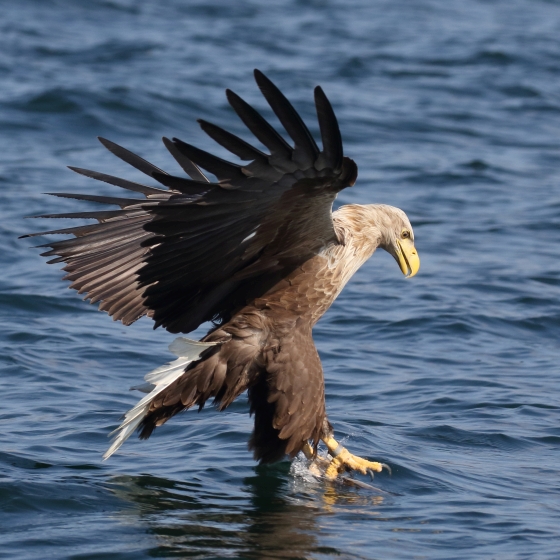White-tailed Eagle

Introduction
Described by some as a flying barn door, it is impossible not to be impressed by this very large and powerful bird.
White-tailed Eagles were widespread throughout Britain & Ireland during the Middle Ages, but because of the effects of habitat loss and persecution they had been lost as a breeding species by 1916. Following a series of successful reintroductions, the first of these launching in 1975 on Rum, we have seen this impressive bird return to our skies.
A study has identified that significant areas of suitable breeding habitat exist here, so there is every hope that the population will continue to expand and return the White-tailed Eagle to its former status.

Key Stats
Identification
ID Videos
This section features BTO training videos headlining this species, or featuring it as a potential confusion species.
Eagles
Songs and Calls
Call:
Status and Trends
Conservation Status
Population Change
It is believed that White-tailed Eagles were widespread in the UK before being driven to extinction by humans at the start of the twentieth century (Green et al. 1996). The White-tailed Eagle population has increased substantially following a successful reintroduction project in Scotland which began in 1975 (Green et al. 1996, Whitfield et al. 2009). The Scottish population has now reached over 100 breeding pairs and a new reintroduction scheme began on the Isle of Wight in 2019 (Eaton et al. 2021).
Distribution
The breeding distribution of White-tailed Eagles is centred around four distinct areas: Outer Hebrides, Wester Ross, Skye and the Small Isles, and north Argyll centred on Mull. This may change as attempts are underway to reintroduce the species to southern England. Most birds stay near their breeding territories in winter, but some juveniles wander widely.
Occupied 10-km squares in UK
or view it on Bird Atlas Mapstore.
or view it on Bird Atlas Mapstore.
European Distribution Map
Distribution Change
Change in occupied 10-km squares in the UK
or view it on Bird Atlas Mapstore.
or view it on Bird Atlas Mapstore.
Seasonality
White-tailed Eagles are present year-round in their northern breeding areas, with additional records of wandering birds reintroduced to southern Britain.
Weekly pattern of occurrence
The graph shows when the species is present in the UK, with taller bars indicating a higher likelihood of encountering the species in appropriate regions and habitats.

Movement
Britain & Ireland movement
Foreign locations of birds ringed or recovered in Britain & Ireland
Dots show the foreign destinations of birds ringed in Britain & Ireland, and the origins of birds ringed overseas that were subsequently recaptured, resighted or found dead in Britain & Ireland. Dot colours indicate the time of year that the species was present at the location.
- Winter (Nov-Feb)
- Spring (Mar-Apr)
- Summer (May-Jul)
- Autumn (Aug-Oct)

European movements
EuroBirdPortal uses birdwatcher's records, such as those logged in BirdTrack to map the flows of birds as they arrive and depart Europe. See maps for this species here.
The Eurasian-African Migration Atlas shows movements of individual birds ringed or recovered in Europe. See maps for this species here.
Biology
Productivity and Nesting
Nesting timing
Egg measurements
Clutch Size
Survival and Longevity
Survival is shown as the proportion of birds surviving from one year to the next and is derived from bird ringing data. It can also be used to estimate how long birds typically live.
View number ringed each year in the Online Ringing Report.
lifespan
Survival of adults
Survival of juveniles
Biometrics
Wing length and body weights are from live birds (source).
Ring Size
Classification, names and codes
Classification and Codes
- Order: Accipitriformes
- Family: Accipitridae
- Scientific name: Haliaeetus albicilla
- Authority: Linnaeus, 1758
- BTO 2-letter code: WE
- BTO 5-letter code: WHTEA
- Euring code number: 2430
Alternate species names
- Catalan: pigarg cuablanc
- Czech: orel morský
- Danish: Havørn
- Dutch: Zeearend
- Estonian: merikotkas
- Finnish: merikotka
- French: Pygargue à queue blanche
- Gaelic: Iolaire-mhara
- German: Seeadler
- Hungarian: rétisas
- Icelandic: Haförn
- Irish: Iolar Mara
- Italian: Aquila di mare
- Latvian: juras erglis
- Lithuanian: paprastasis jurinis erelis
- Norwegian: Havørn
- Polish: bielik (zwyczajny)
- Portuguese: pigargo
- Slovak: orliak morský
- Slovenian: belorepec
- Spanish: Pigargo europeo
- Swedish: havsörn
- Welsh: Eryr Môr
- English folkname(s): Sea Eagle, Erne
Research
Causes of Change and Solutions
Causes of change
The recolonisation of Scotland has arisen directly from the reintroduction project (Whitfield et al. 2009). The original extinction of the species was brought amount by persecution (Green et al. 1996) and some persecution may still limit population growth in some areas.

